"San Francisco. I was born there. "George Takei as Sulu in Star Trek IV: The Voyage Home.
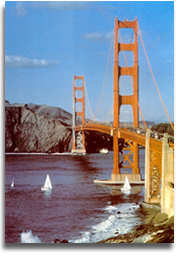
The Chinese call San Francisco "Gum Shan" or "Gold Mountain." The Golden Gate was America's bridge to the Orient. So many Asians came here via this passage that it will always hold a treasured place for Amerasians and Asiaphiles. And at the heart of it is San Francisco's world famous Chinatown, full of mysterious alleys, sumptuous restaurants and cheap tourist gaudiness. Stroll down Grant Street's enticing gift shops, and amidst the Alcatraz t-shirts, postcards and Baoding balls, one recognizable face will stare back at you - the face of the Little Dragon, Bruce Lee. Cheesy Lee tourist posters, along with cheap toy Nunchuku, dominate the other souvenirs. Bruce owns this town called Chinatown.
Bruce Lee. No single person has had a greater impact on today's perception of martial arts by pop culture. And never has there been a greater Asian superstar. You can go to India, to Africa, to Russia, to South America, to just about anywhere, and everyone knows Bruce Lee. With a wicked "wataaah!" Bruce made kungfu into a worldwide household word. And he was the proud son of San Francisco.
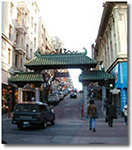
Bruce was born in the Chinese Hospital on Jackson Street. In fact, his first movie appearance (at 3 months old!) was in The Golden Gate Girl. This was the first of 18 rare Cantonese movies Bruce Lee made as a child star, and it was shot in San Francisco. Who could have imagined that this young boy would have dreamed of being a dragon and then become one? From the summit of the shining Gold Mountain descended the ferocious Little Dragon.
Bruce Lee Exhibit
So it was very auspicious for San Francisco's Chinese Cultural Center (CCC) to honor Bruce Lee during the year of his birth by the Chinese Lunar Calendar - the Gold Dragon, 2000. We have seen events that honor Bruce Lee before, but none by the likes of the CCC. In the past, Bruce Lee events have been hosted by exactly who you might expect - martial artists and collectors. The CCC is completely beyond these circles. It is a major community-based, non-profit organization, established in 1965, with no significant connection to the martial arts world. That is until now. Bruce fits into their mission to foster the understanding and appreciation of Chinese and Chinese American art, history, and culture in the United States. Previously, the Center's gallery focused on fine art. Some of their past exhibitions included collections such as Han Dynasty Pictorial Tomb Reliefs and Archaeological Objects, Traditional Costumes and Jewelry from China's Minorities (in collaboration with the Cultural Palace Museum of Nationalities, Beijing, China), and Contemporary Chinese Paintings: An Exhibition from the People's Republic of China. Bruce Lee marks the first pop icon to be showcased by the CCC. Bruce is presented in the context of his cultural significance to the Chinese and Chinese American community. Funding for this exhibition was provided in part by Grants for the Arts of the San Francisco Hotel Tax Fund. It is a great leap for the status of the Little Dragon. The fact that the CCC recognized the influence of Bruce on Chinese culture elevates him beyond the kungfu "B" movie stigma to a symbol of Asian pride.
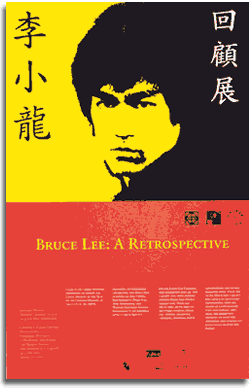
The exhibit included a wide collection of Bruce's personal items donated for display by Linda Lee Cadwell, Jeff Chinn, Dan Inosanto, Perry Lee, Yori Nakamura and Warner Bros. To see Bruce's things, displayed with the reverence usually reserved for Ming vases, slowly creeps up on you. At first, as you meander past the suit he wore for Enter the Dragon, gaze at his Nunchuku, and view the many magazine covers he graced, your reaction is that of nostalgia of an era past. But as you ponder glass cases full of oddities such as a set of Bruce Lee Russian nesting dolls or an award of recognition from the People's Republic of China, the magnitude of the Little Dragon starts to seep in. After examining his writings and drawings, up-close and personal, the power of Lee hits you like a dragon whipping its tail. The full impact of Bruce Lee on the world's perception of Asians is truly immeasurable, and like this exhibit, still vital almost three decades after his passing. He empowered a people internationally humiliated by the Opium Wars, the Second World War and the Cultural Revolution to be able to say, just once, "We are not sick men."
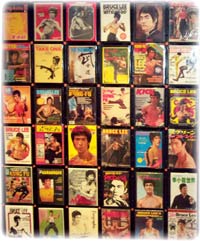 Since Kungfu Qigong Magazine was a media sponsor of this event, I had the good fortune to attend a press conference during the installation. Also present were local reporters and some writers from A magazine's eZine. All the others were outside the martial world. In fact, one reporter wound up questioning me extensively for her article (then overlooked giving me any credit.) But it didn't matter, because while they were dutifully following behind the curator's tour, I was left alone with Bruce's stuff in open glass cases. Amidst some striking pads and information cards lay a pair of Bruce's nunchuks. As a weapon collector, I couldn't resist picking them up for a just a moment. They were well made, designed by Bruce himself and constructed by his favorite craftsman, George Lee. Unique to this pair, Bruce's custom chucks had something I had never seen before, a slight flair towards the end of the shaft. This offered a better grip purchase and added more weight to the blow. It was a small innovation by Bruce, but it was ingenious. Again, the Little Dragon crept in. I could still feel his qi in those chucks. Man, how I would have loved to taken those for a spin!
Since Kungfu Qigong Magazine was a media sponsor of this event, I had the good fortune to attend a press conference during the installation. Also present were local reporters and some writers from A magazine's eZine. All the others were outside the martial world. In fact, one reporter wound up questioning me extensively for her article (then overlooked giving me any credit.) But it didn't matter, because while they were dutifully following behind the curator's tour, I was left alone with Bruce's stuff in open glass cases. Amidst some striking pads and information cards lay a pair of Bruce's nunchuks. As a weapon collector, I couldn't resist picking them up for a just a moment. They were well made, designed by Bruce himself and constructed by his favorite craftsman, George Lee. Unique to this pair, Bruce's custom chucks had something I had never seen before, a slight flair towards the end of the shaft. This offered a better grip purchase and added more weight to the blow. It was a small innovation by Bruce, but it was ingenious. Again, the Little Dragon crept in. I could still feel his qi in those chucks. Man, how I would have loved to taken those for a spin!
A Night with the Nucleus 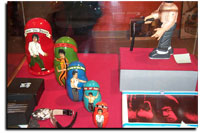
No museum event would be complete without a gala fundraising opening. For this Bruce Lee retrospective, it was a gathering of old friends and loyal followers, with a few members of the CCC, San Franciscan patrons of the arts, thrown in to boot. On an unseasonably warm October night, San Francisco was glimmering in the way that must have inspired Tony Bennett to croon so sweetly. The city by the bay glowed with a romantic purple-pink California sunset, promising an evening of pure San Francisco magic.
At the center of Chinatown lies Portsmouth Square, a park just outside the CCC. That evening, Portsmouth's night market surrounded the opening, bustling with energy of Chinese street hawkers and brimming with the rich aroma of pork buns. A contingent of yellow-clad Falun Gong followers was taking advantage of the crowd by staging a meditation vigil before the Goddess of Democracy statue, erected at Portsmouth following the Tiananmen incident. Amidst this glittering Chinatown spectacle, guests arrived for a private viewing of the gallery. Mingling among the Bruce Lee exhibit was his living legacy, members of the Bruce Lee's martial family, and his original students, the Jun Fan Jeet Kune Do Nucleus. Allen Joe, George Lee, Ted Wong, Taky Kimura, Jerry Poteet, and others were commenting on what they saw, debating about what Bruce's original wooden dummy looked like, reminiscing as they looked upon the items of their beloved friend and teacher.
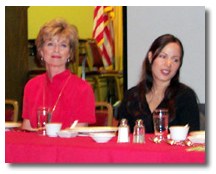
Also present was the next generation, daughters Shannon Lee and Diana Inosanto, as well as many other noted masters such as San Francisco's own Tat Mau Wong, and Wing Chun proponents Garrett Gee and Benny Meng. But the belle of the ball was the ever-graceful Linda Lee Cadwell. Adorned in her signature mandarin-red outfit, and bearing her stunning gold Jeet Kune Do medallion, she was positively radiant, politely engaging all who wanted to meet her. Everyone was pleased with the museum-quality presentation of the installation. The Little Dragon was receiving the honor he was due.
After the viewing, we all made our way across the buzzing square to Chinatown's famous Empress of China restaurant for a lavish $75 a plate fundraising banquet to benefit the CCC and the Bruce Lee Educational Foundation. With its commanding views of the city and its succulent multi-course gourmet offerings, the Empress was packed with eager Little Dragon fans and loyal supporters. During the festivities, a representative of the Mayor's office read the following proclamation:
 "Whereas the CCC along with the Bruce Lee Educational Foundation and the Inosanto Academy of Martial Arts will honor Bruce Lee, the Little Dragon, with an exhibition. "And whereas Bruce Lee will always be remembered as in invincible warrior from movies and television, but he was also a complex individual, charismatic, vivacious. He was more than a fighter. He was also a philosopher, teacher, poet, family man, innovator and eternal seeker. Bruce Lee's legacy has grown, and he has achieved pop culture icon status. And his collection of diaries, personal letters, drawings, philosophical writings clothing, weapons, training equipment, movie memorabilia, and other personal items promises to draw the attention of enthusiasts around the world. "Now therefore, let it be resolved, that I, Willie L. Brown Jr., Mayor of the city and county of San Francisco, honor in recognition of the Little Dragon in the year of the golden dragon, do hereby proclaim October 21st 2000 as Bruce Lee Day in San Francisco." Needless to say, "da mayor's" gesture drew a hearty round of applause.
"Whereas the CCC along with the Bruce Lee Educational Foundation and the Inosanto Academy of Martial Arts will honor Bruce Lee, the Little Dragon, with an exhibition. "And whereas Bruce Lee will always be remembered as in invincible warrior from movies and television, but he was also a complex individual, charismatic, vivacious. He was more than a fighter. He was also a philosopher, teacher, poet, family man, innovator and eternal seeker. Bruce Lee's legacy has grown, and he has achieved pop culture icon status. And his collection of diaries, personal letters, drawings, philosophical writings clothing, weapons, training equipment, movie memorabilia, and other personal items promises to draw the attention of enthusiasts around the world. "Now therefore, let it be resolved, that I, Willie L. Brown Jr., Mayor of the city and county of San Francisco, honor in recognition of the Little Dragon in the year of the golden dragon, do hereby proclaim October 21st 2000 as Bruce Lee Day in San Francisco." Needless to say, "da mayor's" gesture drew a hearty round of applause.
Following dinner, John Little showed his short documentary, Bruce Lee: In His Own Words. This 20-minute video was the premium in Warner Bros. 25th Anniversary re-release of Enter the Dragon and has been shown at other Bruce Lee events. It was an appropriate closure to a magical evening, letting Bruce speak for himself on the night we all came to honor him. When Linda first viewed an advance copy of this film, she found herself weeping. She called Little immediately after and said, "It was like Bruce was in the room with me again. I found myself really, really missing him after watching this." As we bid each other goodnight, everyone drifted back into the mystery of Chinatown, knowing full well we would see each other again the next afternoon.
A Warrior's Journey into The Game of Death
What happened the next afternoon? It was the premiere showing of John Little's other documentary Bruce Lee: A Warrior's Journey*. This feature-length film, scheduled for direct-to-video release in spring of 2001, includes a reconstructed version of the final fight scene of The Game of Death. The debut was a smashing success, but then it couldn't have found a more enthusiastic audience.
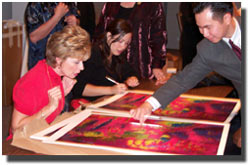 The original released version of The Game of Death, released in 1973, was like a gothic ghost story. Unable to complete the film due to Lee's death, clips from previous movies, shoddy special effects and an unconvincing impersonator tried to redeem the story. In the newly generated plot, a "fake" death was staged for the lead character, which was supposed to account for the different facial features of the impersonator. In a ghastly move, the film used actual footage of Bruce Lee's funeral to depict this insensitive plot device. That movie, and the circumstances around it, reeked of death and gravediggers. It makes a morbid double feature with The Crow, whose plot involved a dead man coming back from the grave, and whose production took the life of Bruce's only son, Brandon.
The original released version of The Game of Death, released in 1973, was like a gothic ghost story. Unable to complete the film due to Lee's death, clips from previous movies, shoddy special effects and an unconvincing impersonator tried to redeem the story. In the newly generated plot, a "fake" death was staged for the lead character, which was supposed to account for the different facial features of the impersonator. In a ghastly move, the film used actual footage of Bruce Lee's funeral to depict this insensitive plot device. That movie, and the circumstances around it, reeked of death and gravediggers. It makes a morbid double feature with The Crow, whose plot involved a dead man coming back from the grave, and whose production took the life of Bruce's only son, Brandon.
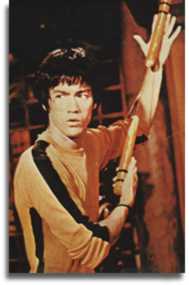 Little's new documentary redeems The Game of Death by putting the footage fragments in proper perspective as a documentary and restoring Lee's vision using his extensive notes. At last, we can see the film as it was meant to be. For the community of Bruce Lee aficionados, it provides closure on one of the darkest chapters of the Little Dragon's life and work.
Little's new documentary redeems The Game of Death by putting the footage fragments in proper perspective as a documentary and restoring Lee's vision using his extensive notes. At last, we can see the film as it was meant to be. For the community of Bruce Lee aficionados, it provides closure on one of the darkest chapters of the Little Dragon's life and work.
Immediately following the screening, John Little and Linda Lee Cadwell answered questions from the audience. In the most touching moment of the weekend, someone asked Linda which achievement she thought Bruce most proud of, and she answered emotionally that it was fathering Brandon and Shannon. For a moment, we found ourselves peering deep inside the heart of the Little Dragon to discover the soul of this mighty warrior was powered by love.
Where No Martial Artist Has Gone Before
One can only ponder the magnitude of Bruce Lee's influence upon Asians and the world perception of Asians. As an Asian American myself, I can remember being raised with two only Asian role models, Mr. Sulu from Star Trek and Bruce Lee. Growing up in a predominantly white community, Mr. Sulu, although groundbreaking, wasn't too much help when push came to shove. But Bruce, well, he got me through a challenge or two. I remember as a child, being confronted by a group of local boys over my racial differences. Readying myself for the potential fight, I invited the attack by tucking my chin and sinking my stance, exactly how I imagine Bruce might have done. Now every martial artist has had to endure some chiding from a sarcastic Bruce Lee imitator, and most can do their own Bruce impersonation, but this was something completely different. This was a moment of truth, albeit on a school playground. Instead of mocking imitation, it was martial inspiration.
Those bullies, they backed down. I hesitate to say I bluffed them. Rather, I like to think they got a whiff of the little dragon and fled in fear. It's almost as if the Little Dragon's spirit can enter you, if you're open to it. While I probably didn't escape much more than a schoolyard trash-canning, it was a victory I will always savor. I suppose you can call it the art of fighting without fighting.
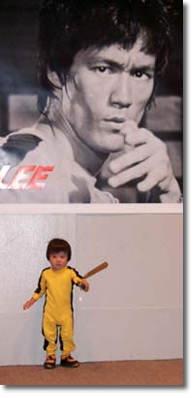 Eddie Murphy once commenting on his performance in the finale to 48 Hours. He confessed that he did the scene simply by impersonating Bruce Lee. Knowing Bruce is a source of power. Lee's portrayal of those martial moments of truth, his "game of death" if you will, expressed something primal, something animal, and something very lethal. It touches a universal chord within all of us. When Mr. Sulu could only offer a submissive "aye-aye Captain," Bruce Lee showed the world the way of the dragon.
Eddie Murphy once commenting on his performance in the finale to 48 Hours. He confessed that he did the scene simply by impersonating Bruce Lee. Knowing Bruce is a source of power. Lee's portrayal of those martial moments of truth, his "game of death" if you will, expressed something primal, something animal, and something very lethal. It touches a universal chord within all of us. When Mr. Sulu could only offer a submissive "aye-aye Captain," Bruce Lee showed the world the way of the dragon.
As the weekend's festivities came to a close, we were all left with a profound sense of the Little Dragon's legacy. This exhibit marked a major shift in the perception of Bruce Lee. Combating racial stereotypes and the "low-brow" reputation of kungfu movies, the Little Dragon is finally transcending into a respected artist. It has taken those outside the martial world almost three decades to realize that this was a truly extraordinary man. Perhaps he was ahead of his time. And with the impending release of The Warrior's Journey, today's generation will get a chance to experience the return of Little Dragon. The next year of the Gold Dragon isn't until 2060 and it will be up to the next generation to preserve the Little Dragon's legacy until then. Right now, things are busy looking good.
About
Gene Ching :
![]() Gene Ching is a Shaolin Desciple & associate publisher of Kungfu/Qigong Magazine
Gene Ching is a Shaolin Desciple & associate publisher of Kungfu/Qigong Magazine
![]() Print Friendly Version of This Article
Print Friendly Version of This Article
















